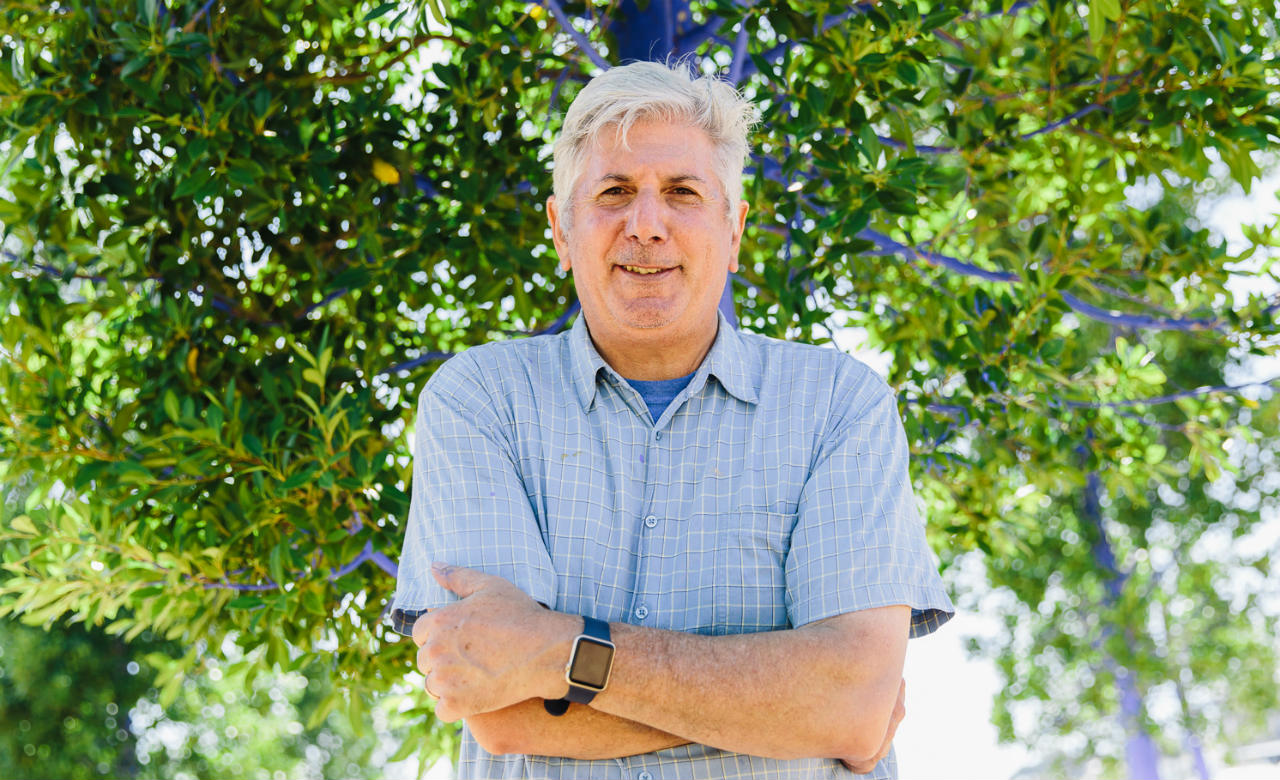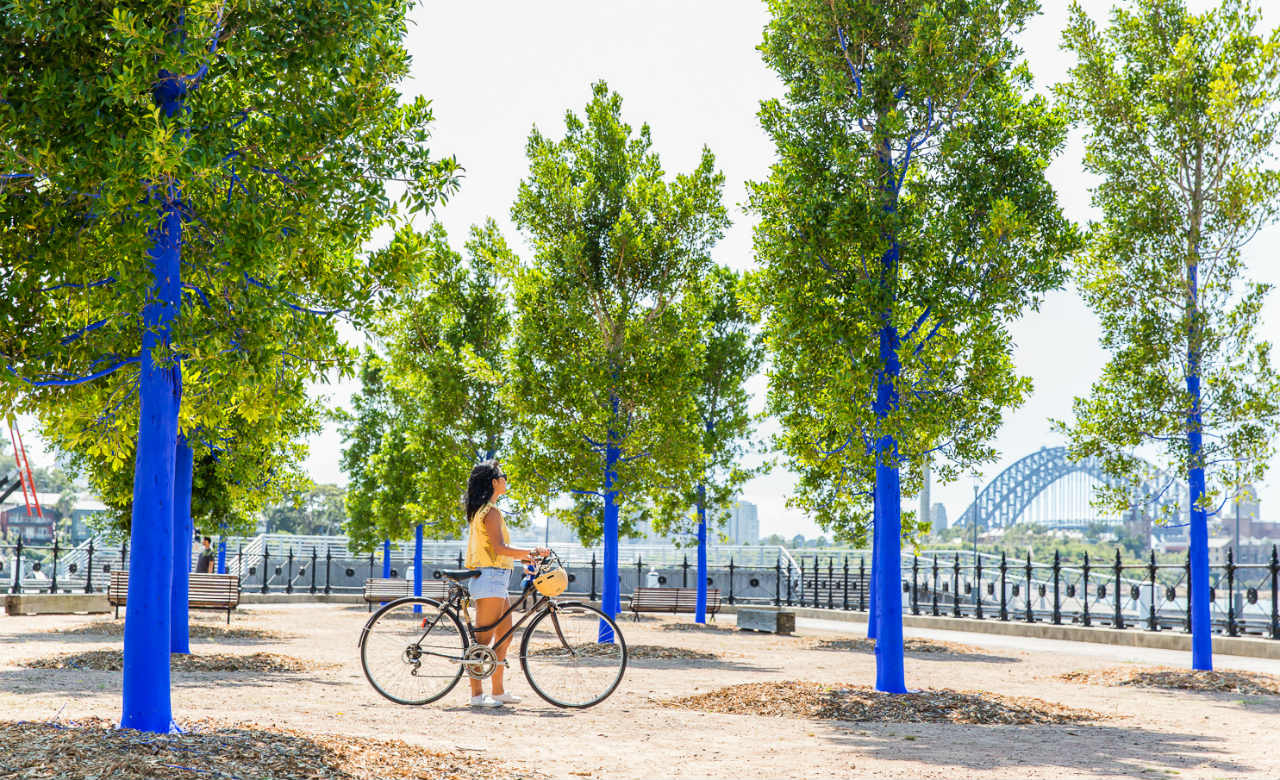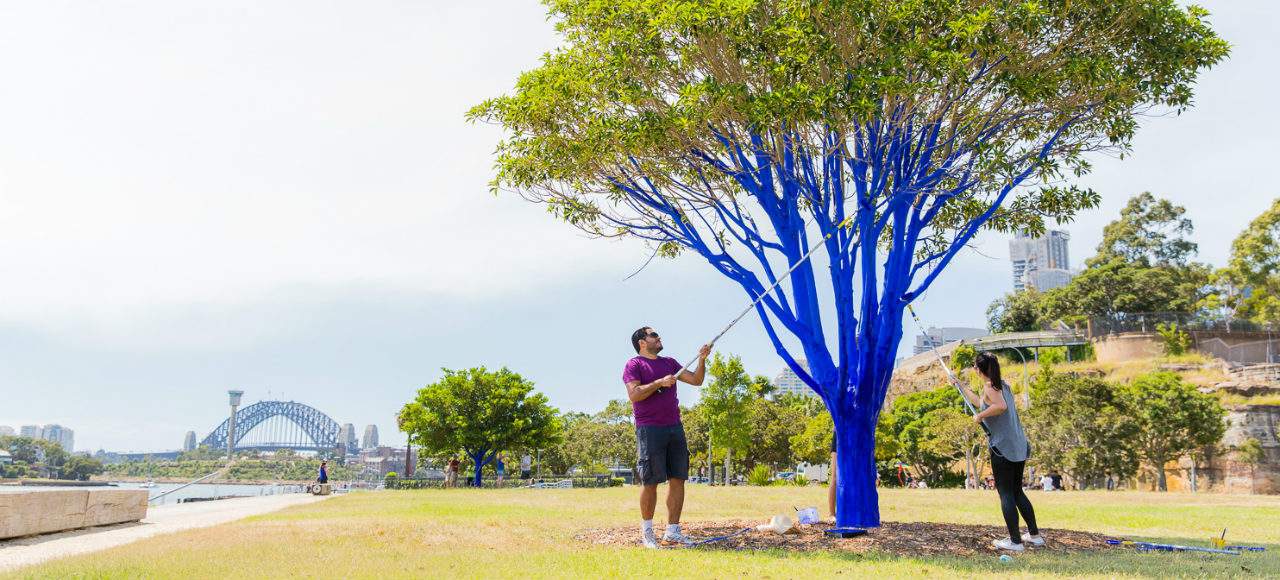Why Is This Artist Colouring Sydney's Trees Electric Blue?
Konstantin Dimopoulos talks public art and getting people to pay attention.
In partnership with
"I always quote Einstein, who said that if an idea is not at first absurd, then there's no hope for it," says artist Konstantin Dimopoulos. "I guess what Einstein meant was that normal ideas don't go anywhere."
Einstein may very well have been onto something. As a general rule, human beings tend to be attracted to things outside of the ordinary, and are more likely to consider big ideas if they're delivered in a way that grabs our attention. It's for this reason that Dimopolous, intent on generating discussion about deforestation, is colouring the trees in Pyrmont's leafy Pirrara Park a radioactive shade of blue.
Part of this year's Art and About program in Sydney, The Blue Trees is actually an ongoing project, with Melbourne-based Dimopoulos having previously tampered with the foliage in a number of global cities including London, Vancouver and Seattle. Ahead of its debut in Sydney, we spoke with the artist about what he hopes audiences will make of his endeavour, and the importance of public artwork in shaping the way people think.

Where did the idea for The Blue Trees come from?
"I moved from New Zealand to Australia in 2003, and what we don't have in Wellington is a lot of trees, because it's so windy. So the first thing I saw was the amazing trees. Then I got to talk to people from [Melbourne community-based activist organisation] Friends of the Earth. One person who'd just come back from South East Asia showed me images of huge deforestation. I remember his comment was 'I wish we could get it on the front page of the newspapers instead of just a postscript.'
"I've always had in the back of my mind the idea of social art. And it comes from people like Joseph Beuys, the German artist. It's using art to highlight issues that happen outside of that arena. We're highlighting, through colour and through art, a hugely serious issue of global deforestation."
So once you've decided to make art about deforestation, how do you settle on colouring trees blue?
"That is a question that I really don't have an answer to. I was walking by the MCG, and the way they set the trees, they're on both sides of the road, and they almost create this church-like canopy over the top of you, and the trunks are like the pillars. And I saw that and for some reason I had this idea of blue trees. I don’t know what it was.
"It's such a bizarre colour for a tree, and that was the idea. You colour something completely different from what people expect. I've said to people that if I coloured them brown, nobody would care. It's about creating something that has a magical quality that makes people stop. And it's not just a blue, but an electric blue. When people see it on my website they think it's been photoshopped. It almost looks like it's glowing, or like it's some form of radiation."

It really does look quite unnatural.
"That's exactly it. It looks unnatural. But what we're trying to say is that the real unnaturalness is when you have human beings destroying huge amounts of forest without any thought that we're changing the environment and the ecosystem. And once that habitat goes, [animals] disappear. We don't think about that. We tend to think that we're the top dog.
"There are statistics, which I won't go too much in to, but there was one recently from a guy called Matt Hansen, a professor at the University of Maryland, who said that we lose 50 football fields of forest every minute... These forests have no voices. What I'm trying to do is raise a voice."
What has the reaction to the work been like in other cities?
"Often you can put the most non-toxic of artwork out there, and there'll be someone who dislikes it. People don't have any opinions on life and death, but they have opinions on public sculpture. So whenever you create a public work, there's always someone asking why we've spent money on it. But art is where ideas come from. It's an artistic process. Whether it's Steve Jobs or Picasso, ideas come from that point of wanting to create something. It'd be much cheaper if we removed all the architecture, and all the sculpture, and all the landscape from a community, and just concreted everything. But the people who change the world love theatre, love music, love architecture, love public art.
"I'll give you a quote from Warren Buffett, who said 'I don't know the secret to success, but the secret to failure is trying to please everyone.' Public art isn't going to do that, and The Blue Trees isn't going to do that. But what it does is raise awareness. And it isn't possible for me not to do something when you hear the statistics about global deforestation. As an artist, I'd rather be in the ring throwing the punches than be one of the observers sitting and booing."

The Blue Trees will be coloured by the community from 10am – 4pm on Saturday March 5. More details over here.
Images: Nikki To.






